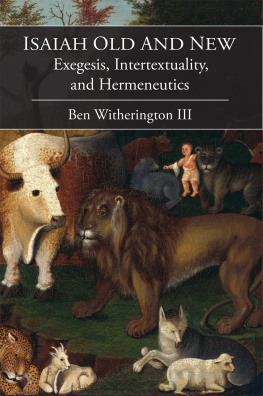All rights reserved.
No part of this work may be reproduced or transmitted in any form or by any means, electronic or mechanical, including photocopying and recording, or by any information storage or retrieval system, except as may be expressly permitted by the 1976 Copyright Act or in writing from the publisher. Requests for permission should be addressed to Permissions, The United Methodist Publishing House, P.O. Box 801, 201 Eighth Avenue South, Nashville, TN 37202-0801, or e-mailed to permissions@umpublishing.org.
On the road with Jesus : teaching and healing / Ben Witherington III.
p. cm.
ISBN 978-1-4267-1216-6 (trade pbk. : alk. paper)
1. Jesus ChristPerson and offices. 2. Bible. N.T. GospelsCriticism, interpretation, etc. I. Title.
All scripture quotations are the author's own translation.
PREFACE
T he further one gets into the life and ministry of Jesus, the clearer it becomes what a complex person Jesus was. It also becomes apparent how challenging his words and deeds were, not merely for those who were antagonistic but even for his own disciples. In this volume of our series, we will be exploring Jesus' Galilean ministry in some detail and looking at the way Jesus presented himself to the peoples of his own region.
In the first chapter we will focus on Jesus the person and look at him as a seer, a sage, and a healer. In the last chapter, we will consider the messianic side of who he was. What did it mean to call him the Messiah, the anointed one of God? In the two middle chapters, we will look at the Sermon on the Mount, an essential summary of some of Jesus' core teachings, and then we will examine some of Jesus' relationships: with John the Baptizer, with the Pharisees, with the Sadducees, and with the Zealots. Along the way, as we travel down the road with Jesus, eventually heading to Jerusalem and his date with destiny, we will reflect on the significance of all this material for faith in Jesus today.
The four DVD sessions that go with this guidebook are not intended to duplicate the four chapters in this book but to supplement them so the reader will have a more detailed contextual understanding of the Gospels. As I like to put it, a text without a context is just a pretext for whatever one wants it to mean. Studying the life of Jesus in its original historical, archaeological, social, and religious contexts helps us rule in and rule out certain ways of interpreting the Man who Fits No One Formula: Jesus of Nazareth.
Christmas 2011
CHAPTER ONE
JESUS THE SEER,
THE SAVIOR, THE SAGE
The parables were dark sayings meant to tease the mind into active thought about the Kingdom.
C. H. Dodd
O YOUNG AND FEARLESS PROPHET
O ne of the main reasons John the Baptizer surprised people is that some Jews of his time thought there were no more prophets in the land, and that there had not been for some time. John caused people to reassess, so that when Jesus came on the scene, the buzz was that perhaps he was a prophet as well, a prophet like John. And after John died, somebody even suggested he was John back from the dead (see Mark 8:28)! But there were prophets and then there were prophetsone size did not fit all. In fact there was a northern style of prophet, and there was a southern style of prophet, and if one came from Galilee, the natural assumption would be that a prophet would be like Elijah, who along with Elisha, ministered to the northern tribes, to Israel rather than to Judah. If we analyze the chronicles of the ministries of Elijah and Elisha what we mainly find are two action prophetsprophets noted for miracles for the people and for sticking their noses in the political business of royalty. At least in regard to the former, Jesus appeared to be like Elijah. Elijah, after all, had also brought back someone from the dead. And Jesus had called the ruler of Galilee, Herod Antipas, "that fox" and was critical of his marriage and his treatment of John the Baptizer, and rightly so.
Judaean prophets in the classical mode were oracular prophets. They would hear a late word from God, and then quote it verbatim, often using the "thus says Yahweh..." formula. They were mouthpieces who had a good earpiece tuned into God's frequency. This was clearly not Jesus' modus operandi. Not once does he speak as a mere mouthpiece for the Father. And because of this, some have suggested Jesus was not a prophet. The problem with that conclusion is that Jesus even calls himself a prophet more than once (for example, in Mark 6).
We need to expand our horizons and realize that there were classical prophets and there were action prophets, there were parable-telling prophets (see Nathan and his confrontation with David), and there were apocalyptic seers. If we have to characterize Jesus, he was like all of these sorts of prophets, except the classical prophets. He told parables, he confronted authorities, he performed miracles, and yes, he had visions. We have already discussed the latter when we investigated his baptism and his early temptations in the wilderness.
But of course Jesus was both more and other than a prophet. John, so far as we know, performed no miracles, but Jesus performed miracles no one had seen before in Judaism, specifically the healing of a man born blind (we have no such story in the Old Testament or intertestamental Judaism Jesus' miracles were performed in the context of working as a messianic prophet and a messianic sage. He was indeed a man who could not be pigeonholed.
THE MIGHTY WORKS OF A MIGHTY MAN
There are two traditions about Jesus' miracles, a northern tradition and a southern tradition. In Judaea, Jesus was primarily noted for performing "sign miracles," that is miracles that had high symbolic content that pointed away from themselves to the one performing the sign. They were signs that the king had come. In Galilee, Jesus performed "mighty works," which were indicators that the Kingdom, or Dominion, had arrived. The former included dramatic healings and raisings from the dead and even judging miracles (for example, the cursing of the fig tree) but no exorcisms. The latter included every kind of miracle imaginable: healings, raisings, nature miracles, exorcisms; you name it, Jesus could do it. It is interesting that in the Synoptic Gospels the miracles are called "mighty works" (dunameis, from which we get the word dynamite!) whereas in John they are called semeion, emphasizing not so much their power as their symbolic character.
If we examine closely the miracle traditions in the four Gospels, there are a variety of things that stand out. In Mark's Gospel, particularly in its first half, exorcisms seem to be the most prevalent miracle along with healings, whereas in the Fourth Gospel and in Judaea, it's a different story. The second thing to note is that Jesus does not perform miracles using magic or sacred formulae or recipes, unlike others who claimed to do miracles in his era. Jesus does not do miracles on the basis of someone else's authority or power, but on the basis of his own. Right from the start in Galilee when he heals the man with the "unclean spirit" (that is, a spirit that made the man unclean) the crowds in the synagogue in Capernaum are amazed and note that Jesus seems to have independent, or personal authority, not derived power and authority. In a culture where it was assumed that only God had inherent power and authority, this was shocking. The third thing to notice about Jesus' miracles is they are largely effortless. Jesus doesn't have to wrestle with demons in a cage match or go through a prolonged process of healing; however, at least once he chooses to heal a man in stages. Several times he has the one being healed participate in his or her own curative process ("Go wash," he says to the blind man. "Go see the priest," he says to the man he has made clean). Jesus can even heal at a distance and does so even for foreigners like a Syrophoenician woman or a centurion near Cana.













